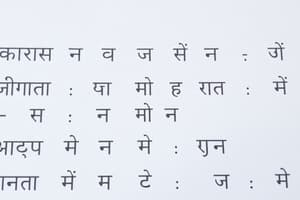Podcast
Questions and Answers
Match the following cases in Hindi grammar with their usage:
Match the following cases in Hindi grammar with their usage:
Nominative = For the subject Accusative = For the direct object Oblique = For instruments and indirect objects Genitive = For possession
Match the following gender distinctions in Hindi with their descriptions:
Match the following gender distinctions in Hindi with their descriptions:
Masculine = Distinguished by the ending of the noun Feminine = Distinguished by the ending of the noun
Match the following features of Hindi cases with their examples:
Match the following features of Hindi cases with their examples:
Locative case = Indicating location Dative case = Indicating recipient
Match the following parts of Hindi script with their origin:
Match the following parts of Hindi script with their origin:
Match the following with their correct categories in Hindi alphabet:
Match the following with their correct categories in Hindi alphabet:
Match the following sounds with their classification in Hindi alphabet:
Match the following sounds with their classification in Hindi alphabet:
Match the following with their correct representation in Hindi alphabet:
Match the following with their correct representation in Hindi alphabet:
Match the following descriptions with the relevant sections in Hindi alphabet:
Match the following descriptions with the relevant sections in Hindi alphabet:
Match the following with their significance in Hindi alphabet:
Match the following with their significance in Hindi alphabet:
Flashcards are hidden until you start studying
Study Notes
Introduction
Hindi is India's official language and is widely spoken across the globe due to migration, tourism, and globalization. This language belongs to the Indo-European language family, specifically the Indo-Iranian branch. In this article, we delve deeper into the aspects of the Hindi language by discussing its grammar and alphabet.
Hindi Grammar
Grammar plays a crucial role in every language, providing structure and rules for constructing sentences correctly. Several features distinguish Hindu grammar:
Word Order
In basic sentences, the order is Subject-Verb-Object (SVO), which is similar to English. However, the case system is complex and flexible, allowing the word order to change depending on the subject and object agreement.
Case System
Hindi uses a highly inflected case system. The six main cases include nominative (for the subject), accusative (for the direct object), oblique (for instruments and indirect objects), genitive (for possession), locative (for location), and dative (for recipient). Additionally, Hindi also distinguishes between singular and plural forms.
Gender
Like many languages, Hindi distinguishes between masculine and feminine gender for nouns. Unlike English, however, Hindi does not have neuter or other non-gender distinctions. Instead, gender is determined by the ending of the noun, and this can sometimes change based on the speaker's region or dialect.
Hindi Alphabet
The Hindi script consists of characters derived from Brahmic scripts. It comprises Devanagari script, which is the standard script for Hindi. The letters (Varna) of the Hindi alphabet are arranged in three sections:
-
Akshar: The first section includes basic consonants (called Vyanjana Varnas) and vowels (known as Varna). Consonants can be further divided into four classes: voiced sounds (Shuddha), unvoiced sounds (Avashthita), sibilants (Teen Bindu), and Mridang.
-
Anusvara: The second section represents various matras (short syllables) called Anuvaka. These matras include Anusvara (ऊं् / ूं्), Visarga (ॠ), and others like Hamsa, Yuvak, etc., which act as sounds or syllables at the end of words.
-
Combining characters: The third section consists of various combining forms called Deeksha. These are used to modify letters, create new sounds, or indicate different pronunciations. For example, adding Retroflex (रेत्रोफ़लक्स्) to a consonant can change its pronunciation.
Conclusion
Understanding the grammar and alphabet of Hindi is essential for anyone interested in learning this language. While this article provides an overview, further study is necessary to master these aspects. With patience and practice, you will soon be able to read, write, and speak Hindi fluently.
Studying That Suits You
Use AI to generate personalized quizzes and flashcards to suit your learning preferences.




